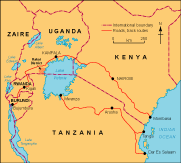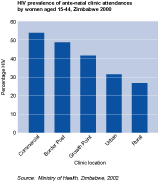Section 2: HIV/AIDS
D:
Geography
Contents:
The epidemic wave (or curve) for HIV/AIDS at the global scale is shown on the left.
It shows the numbers of people estimated to be HIV+ and to have AIDS up to 2003. This is not the same across the world, and varies by country.
Click on the graph to see a larger version of the global curve, and discussion of what it shows.
It isn't just between countries that there are differences in the prevelance of HIV/AIDS, there are differences between different areas and different groups of people within the same country.
The earliest epidemics were among:
- homosexual men in the developed world (mainly North America, Europe and Australasia)
- heterosexual men and women in Africa.
These epidemics have followed very different patterns over their 20-year history.
Developed countries
The changes in the spread of HIV/AIDS in developed countries have mainly been due to a change in the groups of people who are susceptible to the disease.
Originally, HIV/AIDS in the developed world was associated with homosexual men.
In the early years of the disease, over 90% of cases were in homosexual men. As a result, in the 1980s, HIV/AIDS was often described as 'the gay plague'.
Because of this, the early education campaigns which focussed on safe sex were targetted at gay men and these have been successful in reducing the transmission rate amongst this population.
In developed countries, the number of new cases of HIV/AIDS as a result of unprotected homosexual sex have fallen. This does not mean that the spread of HIV/AIDS is falling, and the disease is increasingly spread through unprotected heterosexual sex.
The graph on the left show the change in the different ways in which HIV/AIDS is transmitted in the UK. Click on the graph to see a bigger version and further discussion.
The picture in Africa is very different to that in developed countries.
Rates of HIV prevalence and AIDS deaths have risen relentlessly in most countries in Africa, but more so in some countries than others.
The map on the left shows the HIV prevalence rate for adults in Africa by country for 2003. Click on the map to see a bigger version and discussion.
Change over time
The pattern on the map hasn't always been like this. The difference between the rates of HIV/AIDS in different African countries has changed over time.
The graph on the left shows the rates of infection over time for four African countries. Each of the curves show a very different pattern.
Click on the graph to see a bigger version and further discussion.
Because the main way in which HIV/AIDS is spread is through unprotected sex, there is a local pattern of spread that follows individual patterns of sexual partners.
Clearly long-term partners of those who are infected (such as husbands, wives, boyfriends, girlfriends) are likely to both become infected if adequate precautions aren't taken.
HIV/AIDS will spread into the population at large when people have multiple sexual partners. This can occur within their own local areas, but sexual infidelity is more likely where the couple are separated and alternative sexual opportunities are either sought or become available.
The spread of HIV/AIDS has therefore been strongly associated with population movements, and migrants are among the most vulnerable groups.
Migration and HIV/AIDS
In Africa the early spread of HIV/AIDS was associated with long distance trucking routes and the role of truck drivers having relationships with commercial sex workers along the routes at truck stops.
The map on the left shows the area around Lake Victoria, highlighting the main transport routes. Click on the map to see a bigger version and discussion.
More generally, migrants tend to go to towns to do business and to look for jobs, where they may have sexual encounters with infected persons.
In Africa, migrant labourers are highly vulnerable to HIV/AIDS.
This is especially important in southern Africa where the long-established contract migrant labour system keeps migrants way from home for the many months of their contracts, typically at mines, where they have access to commercial sex workers, mostly carriers of the virus.
One important factor which has aided the spread of HIV/AIDS in Africa is that migration is often circulatory rather than permanent - i.e. people move away for a short time and then move back home again.
Because of this, when the migrants return home, they bring back not only money and goods acquired away from home, but may also return HIV+ and then infect their partners.

Migrant workers getting on a bus to Nairobi. Click picture to see larger version.
The spread of HIV/AIDS is most rapid in urban areas (towns and cities). In the early period in Africa urban areas typically had more than twice the prevalence rates of rural areas.
The graph on the left shows the difference in HIV/AIDS prevalence between different geographical settings and identified rural and urban areas. Click on the graph for a bigger version and discussion.
As well as it mainly being people in urban areas who contracted HIV/AIDS, in Africa, it was typically the educated elite that was affected.
Those who are educated tend to have looser ties to traditional family and community structures and so are more likely to have multiple sexual partners.
Control
While HIV/AIDS was originally higher in urban areas in Africa, infection rates have stabilised or even fallen in many urban areas. But the rural / urban gap remains. This is due to two main reasons:
- While education campaigns have had most success in urban areas, they also reach rural areas. Changing behaviour to safe sex and having fewer partners has affected both rural and urban populations.
- People in urban areas have much better access to ARV drugs. This is because those who are wealthy can afford the drugs, and because people in urban areas are likely to be closer to a hospital where they can receive the treatment than are people in rural areas. But this is still affecting such a small proportion of even the urban population in Africa that it has little effect on rural / urban differences.

Now test what you've learnt from this page. (Note to try again on multi-choice questions you must first click reset.)
3. Which TWO of these areas have the highest potential for further growth in HIV rates?
Click the two you think they are and then click submit to find out if you are correct. Unless you get both right it will tell you you're wrong. Click reset to try again.
6. Which TWO countries in each list fit into the HIV prevalence category at the top of the list?
Click the two you think they are and then click submit to find out if you are correct. Unless you get both right it will tell you you're wrong. Click reset to try again.
High (>10%)
Medium (5%-10%)
Low (>5%)

















